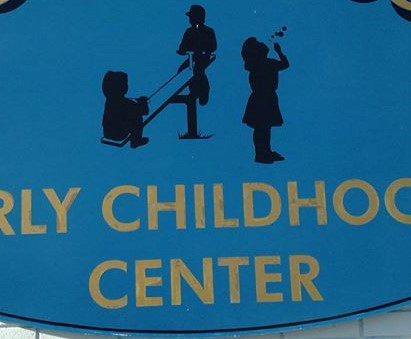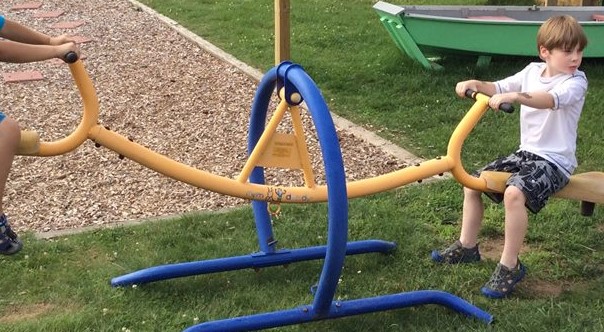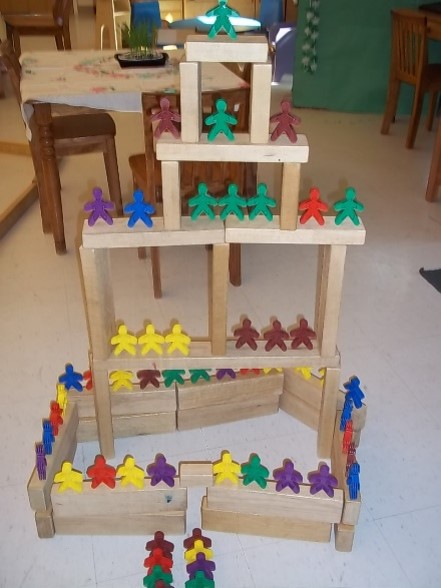When deciding how to solve problems, children learn that solutions may vary if viewed from an ethical standpoint. Here are 5 different ethical approaches to problem-solving:
(1) Utilitarian Approach: Benefits most but not all(2) Rights Approach: Protects the rights of all(3) Fairness or Justice Approach: Distributes benefits fairly among all(4) Common Good Approach: Benefits the common good(5) Virtue Approach: Promotes virtue and development of characterExamples which can be used in early childhood settings: 1. Utilitarian Approach. Benefits most but not all. Eminent Domain is an excellent example of this. A city may wish to put in a new road or airport, for instance, and what is in the way may have to be removed or relocated (houses, fields, stores, etc.). This could be reacted with puppets, a felt story, drawings, etc. The block area would be a nice setting for it. 2. Rights Approach. Protects the rights of all. For example, everyone in an early childhood center deserves to be treated with respect and kindness, to have a chance to tell their side of a story, to be able to seek help when needed, to have water when thirsty, access to food when hungry, access to the bathroom when needed, access to rest when tired, and so forth. Many school settings have the children generate a Code of Conduct which applies to everyone. When children are part of the generation of a Code of Conduct, they are more invested in it and more understanding of what it is about. 3. Fairness/Justice Approach. Distributes benefits fairly among all. Here is an example from an early childhood center in NH: “We had an example of the Justice Model today! The children were gathered, ready to go outside to the playground. However, the door through which we usually exit was blocked due to a painting project by our maintenance peole. So, the problem to be solved was: How do we get outside today? As a group, we processed possible solutions. One child said, “We can go out through Miss Lori’s room!” Another child said, “We can go out through the kitchen!” Other options included not going out at all, or waiting until the painting project was completed. At this point, a heavy discussion ensued as to which room we should exit from. Children had very strong opinions on this. It was clear that the group was all in favor of going outside right away, but some wanted to exit through Miss Lori’s door and others through the kitchen door. I was going to facilitate our usual method of voting to determine the solution, but suddenly the Justice Ethical Model popped into my mind. Perhaps there was a way to satisfy everyone – distributing the benefits of the solution equally… I brought this up to the children, and asked if there was a solution where everyone could get their way. A couple of children said that we could go out in two groups! One group through Miss Lori’s door and the other group through the kitchen door! So we did this! Esther led the “Miss Lori door” group, and I the kitchen door group! Only an hour earlier I had been musing about how to present these rather abstract, complex ethical models to the children in a way they could understand. Fate easily resolved this situation!” 4. Common Good Approach: Benefits the “common good.” Here is an example from an early childhood center whose children wished to have a seesaw for their playground – benefiting all of them! The story follows: “We talked about our school sign today as we planted flowers in the new window boxes. One boy asked why, if there is a seesaw on the sign, there isn’t one on the playground… Good point! We called everyone together to problem-solve how to get a seesaw for the school. Here are the solutions that the children brainstormed: (1) Make one (2) Buy one (3) Borrow one (4) Ask the Boy Scouts to get us one! Two Boy Scouts had just finished their Eagle Projects adding wonderful items to our playground, so it made perfect sense to ask them to install a seesaw for us! We mentioned to the scouts that they had made an impression on us, because the children now consider them a way to make playground dreams come true. The scouts then found an old but very usable seesaw they had had as children, and donated it to the school!” 5. Virtue Approach: Promotes virtue and development of character. Sometimes a solution to a problem may hurt someone’s feelings, or interfere with a personal vision. An example might be if a child were building a tower in the block area, and others wanted to join in. Should it then become a group building project? Collaboration, and so forth? Or should the original child be allowed to finish what he had started (Imagine if Michelangelo had had help on a sculpture, or da Vinci on one of his works…) Sometimes collaboration is good, and sometimes individual expression is good. It can be a process deciding which is most beneficial in a situation… History and description of the 5 ethical models: Philosophers have developed five different approaches to values to deal with moral issues. The Utilitarian Approach To analyze an issue using the utilitarian approach, we first identify the various courses of action available to us. Second, we ask who will be affected by each action and what benefits or harms will be derived from each. And third, we choose the action that will produce the greatest benefits and the least harm. The ethical action is the one that provides the greatest good for the greatest number. The Rights Approach Of course, many different, but related, rights exist besides this basic one. These other rights (an incomplete list below) can be thought of as different aspects of the basic right to be treated as we choose.
In deciding whether an action is moral or immoral using this second approach, then, we must ask, Does the action respect the moral rights of everyone? Actions are wrong to the extent that they violate the rights of individuals; the more serious the violation, the more wrongful the action. The Fairness or Justice Approach Favoritism gives benefits to some people without a justifiable reason for singling them out; discrimination imposes burdens on people who are no different from those on whom burdens are not imposed. Both favoritism and discrimination are unjust and wrong. The Common-Good Approach The common good is a notion that originated more than 2,000 years ago in the writings of Plato, Aristotle, and Cicero. More recently, contemporary ethicist John Rawls defined the common good as “certain general conditions that are…equally to everyone’s advantage.” In this approach, we focus on ensuring that the social policies, social systems, institutions, and environments on which we depend are beneficial to all. Examples of goods common to all include affordable health care, effective public safety, peace among nations, a just legal system, and an unpolluted environment. Appeals to the common good urge us to view ourselves as members of the same community, reflecting on broad questions concerning the kind of society we want to become and how we are to achieve that society. While respecting and valuing the freedom of individuals to pursue their own goals, the common-good approach challenges us also to recognize and further those goals we share in common. The Virtue Approach Virtues are attitudes or character traits that enable us to be and to act in ways that develop our highest potential. They enable us to pursue the ideals we have adopted. Honesty, courage, compassion, generosity, fidelity, integrity, fairness, self-control, and prudence are all examples of virtues. Virtues are like habits; that is, once acquired, they become characteristic of a person. Moreover, a person who has developed virtues will be naturally disposed to act in ways consistent with moral principles. The virtuous person is the ethical person. In dealing with an ethical problem using the virtue approach, we might ask, What kind of person should I be? What will promote the development of character within myself and my community? Ethical Problem Solving
This method, of course, does not provide an automatic solution to moral problems. It is not meant to. The method is merely meant to help identify most of the important ethical considerations. In the end, we must deliberate on moral issues for ourselves, keeping a careful eye on both the facts and on the ethical considerations involved. This article updates several previous pieces from Issues in Ethics by Manuel Velasquez – Dirksen Professor of Business Ethics at Santa Clara University and former Center director – and Claire Andre, associate Center director. “Thinking Ethically” is based on a framework developed by the authors in collaboration with Center Director Thomas Shanks, S.J., Presidential Professor of Ethics and the Common Good Michael J. Meyer, and others. The framework is used as the basis for many programs and presentations at the Markkula Center for Applied Ethics. |
These 5 approaches and their history can be found at:
Markkula Center for Applied Ethics
http://www.scu.edu/ethics/publications/iie/v7n1/thinking.html





